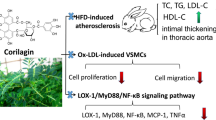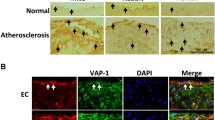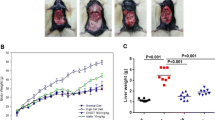Abstract
We sought to investigate whether TSG suppressed the ICAM-1/VCAM-1 expression in dietary atherosclerotic rats and in Ox-LDL-induced U937 cells. For this purpose, 60 male Sprague–Dawley rats were randomly-and-equally divided into six groups. Atherosclerosis was induced by feeding rats a hyperlipidemic diet. TSG (120, 60 or 30 mg/kg/day) was administered by oral gavage. Simvastatin (2 mg/kg/day) was administered as positive control whereas physiological saline (0.9 % NaCl) served as untreated control. After 12 weeks, rats were euthanized by ethyl carbonate (1,200 mg/kg) and aortic wall samples were collected. Besides, U937 cells were stimulated for 48 h by Ox-LDL (80 μg/mL) with and without TSG (120, 60, 30 μg/L) or simvastatin (100 μg/L). ICAM-1/VCAM-1 mRNA expression was determined by RT-PCR and protein expression was detected by immunohistochemistry and/or western blotting. The data show that ICAM-1/VCAM-1 mRNA/protein expression was significantly enhanced in atherosclerotic aortas compared with normal diet group. Ox-LDL-induced ICAM-1/VCAM-1 mRNA/protein expression in U937 cells. Importantly, TSG significantly inhibited ICAM-1/VCAM-1 expression in atherosclerotic aortas in a dose-dependent manner. TSG-pretreatment also inhibited ICAM-1/VCAM-1 expression in Ox-LDL-induced U937 cells. Therefore, we concluded that TSG suppressed the expression of adhesion (ICAM-1/VCAM-1) molecules both in vivo (in aortic wall of dietary atherosclerotic rats) and in vitro (U937 cells).





Similar content being viewed by others
References
Zhang, W., Wang, C. H., Li, F., & Zhu, W. Z. (2008). 2,3,4′,5-Tetrahydroxystilbene-2-0-β-D-glucoside suppresses matrix metalloproteinase expression and inflammation in atherosclerotic rats. Clin. Exp. Pharmacol. Physiol., 35, 310–316.
Ross, R. (1999). Atherosclerosis—an inflammatory disease. New Engl. J. Med., 340, 115–126.
Libby, P. (2002). Inflammation in atherosclerosis. Nature, 420, 868–874.
Price, D. T., & Loscalzo, J. (1999). Cellular adhesion molecules and atherogenesis. Am. J. Med., 107, 85–97.
Springer, T. A. (1990). Adhesion receptors of the immune system. Nature, 346, 425–434.
Cominacini, L., Rigoni, A., & Pasini, A. F. (2001). The binding of oxidized low density lipoprotein (Ox-LDL) to Ox-LDL receptor-1 reduces the intracellular concentration of nitric oxide in endothelial cells through an increased production of superoxide. J. Biol. Chem., 276, 13750–13755.
Michiels, C. (2003). Endothelial cell functions. J. Cell. Physiol., 196, 430–443.
Pearson, J. D. (1999). Endothelial cell function and thrombosis. Baillieres Best Pract. Res. Clin. Haematol., 12, 329–341.
O’Brien, K. D., Allen, M. D., McDonald, T. O., Chait, A., Harlan, J. M., & Fishbein, D. (1993). Vascular cell adhesion molecule-1 is expressed in human coronary atherosclerotic plaques. Implications for the mode of progression of advanced coronary atherosclerosis. J. Clin. Investig., 92, 945–951.
O’Brien, K. D., McDonald, T. O., Chait, A., Allen, M. D., & Alpers, C. E. (1996). Neovascular expression of E-selectin, intercellular adhesion molecule-1, and vascular cell adhesion molecule-1 in human atherosclerosis and their relation to intimal leukocyte content. Circulation, 93, 672–682.
DeGraba, T. J., Siren, A. L., Penix, L., McCarron, R. M., Hargraves, R., & Sood, S. (1998). Increased endothelial expression of intercellular adhesion molecule-1 in symptomatic versus asymptomatic human carotid atherosclerotic plaque. Stroke, 29, 1405–1410.
Manach, C., Mazur, A., & Scalbert, A. (2005). Polyphenols and prevention of cardiovascular diseases. Curr. Opin. Lipidol., 16, 77–84.
Stoclet, J. C., Chataigneau, T., & Ndiaye, M. (2004). Vascular protection by dietary polyphenols. Eur. J. Pharmacol., 500, 299–313.
Shan, L. M., Zhao, Y. L., & Zhang, J. C. (2004). The molecular mechanism of anti-artherosclerosis by the new combination of PPVP in atherosclerotic rats [In Chinese: with an English abstract]. Clin. Pharmacol. Bull., 20, 255–258.
Oyang, J. P., Wang, B. H., & Liu, Y. M. (2002). The effects and the mechanism of atherogenesis by sodium ferulate in hyperlipemia rabbits [In Chinese: with an English abstract]. Chin. Pharmacol. Bull., 18, 207–210.
Poston, R. N., Haskard, D. O., Coucher, J. R., Gall, N. P., & Johnson-Tidey, R. R. (1992). Expression of intercellular adhesion molecule-1 in atherosclerotic plaques. Am. J. Pathol., 140, 665–673.
Ross, R. (1981). Atherosclerosis: a problem of the biology of arterial wall cells and their interactions with blood components. Arteriosclerosis, 1, 293–311.
Poston, R. N., & Johnson-Tidey, R. R. (1996). Localized adhesion of monocytes to human atherosclerotic plaques demonstrated in vitro. Am. J. Pathol., 149, 73–80.
Marlin, S. D., & Springer, T. A. (1987). Purified intercellular adhesion molecule (ICAM-1) is a ligand for lymphocyte function-associated antigen 1 (LFA-1). Cell, 51, 813–819.
Makgoba, M. W., Sanders, M. E., Ginther Luce, G. E., et al. (1998). ICAM-1 a ligand for LFA-1 dependent adhesion of B, T and myeloid cells. Nature, 331, 86–88.
Patel, S. S., Thiagarajan, R., Willerson, J. T., & Yeh, E. T. (1998). Inhibition of alpha4 integrin and ICAM-1 markedly attenuate macrophage homing to atherosclerotic plaques in ApoE-deficient mice. Circulation, 97, 75–81.
Matheny, H. E., Deem, T. L., & Cook-Mills, J. M. (2000). Lymphocyte migration through monolayers of endothelial cell lines involves VCAM-1 signaling via endothelial cell NADPH oxidase. J. Immunol., 164, 6550–6559.
Leca, G., Mansur, S. E., & Bensussan, A. (1995). Expression of VCAM-1 (CD106) by a subset of TCR gamma delta-bearing lymphocyte clones. Involvement of a metalloprotase in the specific hydrolytic release of the soluble isoform. J. Immunol., 154, 1069–1077.
Steinberg, D. (1997). Low density lipoprotein oxidation and its pathobiological significance. J. Biol. Chem., 272, 20963–20966.
Stewart, B. W., & Nagarajan, S. (2006). Recombinant CD36 inhibits Ox-LDL-induced ICAM-1-dependent monocyte adhesion. Mol. Immunol., 43, 255–267.
Jain, M. K., & Ridker, P. M. (2005). Anti-inflammatory effects of statins: clinical evidence and basic mechanisms. Nat. Rev. Drug Discov., 4, 977–987.
Acknowledgments
The authors thank the Priority Academic Program Development of Jiangsu Higher Education Institutions for financial support.
Author information
Authors and Affiliations
Corresponding author
Rights and permissions
About this article
Cite this article
Wang, YQ., Shen, Y., Li, F. et al. 2,3,4′,5-Tetrahydroxystilbene-2-O-β-D-glucoside Suppresses Expression of Adhesion Molecules in Aortic Wall of Dietary Atherosclerotic Rats and Promonocytic U937 Cells. Cell Biochem Biophys 67, 997–1004 (2013). https://doi.org/10.1007/s12013-013-9595-7
Published:
Issue Date:
DOI: https://doi.org/10.1007/s12013-013-9595-7




